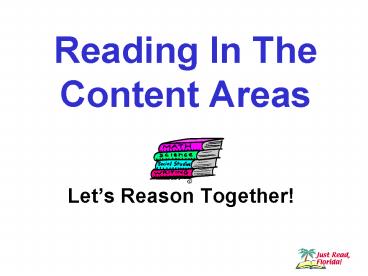Reading In The Content Areas - PowerPoint PPT Presentation
1 / 23
Title:
Reading In The Content Areas
Description:
By using accurate facts and inferences from the text, readers can transform ... Brainstorm the possibilities with your table group. Reading Traditions ... – PowerPoint PPT presentation
Number of Views:113
Avg rating:3.0/5.0
Title: Reading In The Content Areas
1
Reading In The Content Areas
- Lets Reason Together!
2
- Reading Is
- more than personally reacting to a text it is,
instead, interacting with the text, reasoning
with it to develop a hypothesis and justify it.
By using accurate facts and inferences from the
text, readers can transform interpretations into
valid and reasonable thought. - Louise Rosenblatt, 1978 1983
3
Lets Reason Together
- What challenges do teachers and students face
when reading in the content areas? - Brainstorm the possibilities with your table
group.
4
Challenges to Reading in the Content Areas
- Reading Traditions
- Classroom/Curriculum priorities
- Students avoid reading the textbook
- Students cant read the textbook
5
Content Area Reading
- Elements of Textbooks
- Chapter Previews
- Charts, Graphs, Timelines
- Footnotes
- Glossaries, Indexes
- Photos, Illustrations, Maps
- Table of Contents
- Questions, Reviews
- Unit, Chapter, and Section Headings
- Special Features
- Expository Text
- Structures
- Description
- Sequence
- Compare/Contrast
- Cause/Effect
- Problem/Solution
- Question/Answer
6
From Challenges to Solutions
- Integrating reading strategies into the teaching
of science, social studies and math prepares
students to study new information, helps them
learn new vocabulary, improves students
comprehension of textbooks and trade books, and
enables students to learn and think with new
ideas, concepts, and facts. - Laura Robb, 2003
7
Meeting the Challenge Through Coaching
8
Classroom SupportThe Walkthrough
- What are the teachers perceptions about reading
in the content areas? - What do you observe that will inform your
coaching? - What will your next steps be in support of the
teacher and classroom instruction?
9
Picture This
- Youve just completed a brief walk-through at the
request of the science teacher. - Many of the students were having difficulty
reading the assigned textbook pages, while others
had completed the reading and moved on to copying
notes from the overhead. - What areas can you identify for coaching support
in this content area classroom?
10
Classroom Support Coaching
11
Modeling of Strategies
- Show me
- The teacher models and thinks aloud
- Help me
- The teacher provides time for students to
- practice and apply
- Let me
- The teacher releases control gradually and
- moves students toward independence
- Laura Robb
12
Before/During/After Practices
- Students set a purpose for reading and build
their prior knowledge before learning - Students develop ways to monitor and improve
their comprehension while learning - Students apply new information to meaningful
experiences after learning
13
Assess/Activate/Build Prior Knowledge
- Preview/Scan
- Think Aloud
- Brainstorm
- Categorize
- Text Structures
- Graphic Organizers
- Pose Questions
- Read Aloud
- Shared Reading
- Build Vocabulary Concepts
14
Improve Comprehension
- Visualize
- Experiment
- Analyze
- Infer
- Draw Conclusions
- Take Notes
- Outline
- Self-monitor
- Textbook Cues
- Make Connections
- Summarize
- Question
- Predict
- Clarify
15
Connect and Apply New Knowledge
- Reread
- Skim
- Discuss
- Write
- Question
- Synthesize
- Evaluate
- Paraphrase
- Role Play
- Reflect
- Debate
- Simulation
- Oral presentation
- Project
16
Reading Tools to Support Instructional Practices
17
Higher Order Thinking Skills
- In what ways might we support teachers to ensure
students move beyond recall to - application, analysis, synthesis and evaluation
of information?
18
Differentiated Instruction
- Whole group Small group One on one
- Scaffolding
- Leveled texts
- Multiple texts
- Student choice
19
Leveled, Supported Independent Reading
- Provides all students with access to text at
their independent reading levels - Supports student learning through differentiated
instruction - Supports student learning through scaffolding of
instruction - Supports student motivation through content
aligned topics
20
Print/Information Rich Environment
- Multiple texts
- Content word walls/charts
- Reference materials/resources
- Graphic Organizers
- Current displays of student work
- Primary source documents
- Models and manipulatives
21
Professional Development
- Think about the information, instructional
practices, and specific strategies that have been
shared today. - Now, think about the data, teachers , and
students from your particular school site. - In what ways could you provide support to meet
the diverse needs of teachers and support student
learning in the content areas?
22
The Reading Leadership Team
- Coach responsibilities
- Research current, scientifically based reading
practices - Enhance school-site knowledge base for reading in
the content areas - Support school-wide practices/initiatives for
reading across the curriculum
23
References
- Carr, E. (2004). Teaching comprehension A
systematic and practical framework with lessons
and strategies, New York Scholastic. - Fisher, D. Frey, N. (2003). Improving
adolescent literacy Strategies that work, - Harvey, S. Goudis, A. (2002). Strategies that
work Teaching comprehension to enhance
understanding. - Robb, L. (2003). Teaching reading in social
studies, science and math, New York Scholastic. - Santa, C.M., Havens, L.T., Maycumber, E. M.
(1996). Project CRISS Creating independence
through student-owned strategies, 2nd ed.,
Dubuqui, IA Kendall/Hunt Publishing Company. - Vacca, R.T., Vacca, J.L. (1999). Content area
reading Literacy and learning across the
curriculum (6th ed.). New York Longman. - Zimmerman, S. (2002). Seven keys to comprehension
- htttp//www.ed.gov./teachers/how/tools/initiative/
summerworkshop/hinkle/index.html














![Top Content Writing Agencies in India 2022 [Updated 2022] PowerPoint PPT Presentation](https://s3.amazonaws.com/images.powershow.com/9707624.th0.jpg?_=20220110052)
















